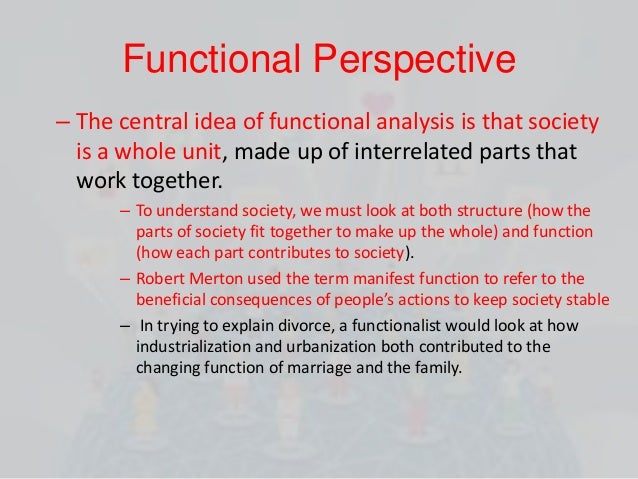Imagine a bustling city, a complex ecosystem, or even your own family. Each element seems independent, yet somehow they all work together harmoniously. It’s a fascinating dance of interdependence, and it’s the very essence of what functional perspective sociology seeks to understand. This sociological lens doesn’t just focus on the individual parts, but delves into the interconnectedness of societal structures and how they contribute to the overall functioning of society.

Image: simplysociology.com
But why is this perspective important? For starters, it helps us see the world around us with fresh eyes. We begin to appreciate the intricate web of social relationships and institutions that shape our daily lives. More importantly, functional perspective provides a framework for understanding social change, explaining how societies adapt and evolve in response to challenges. In essence, this viewpoint allows us to peer into the hidden gears that keep the complex machinery of the social world running.
The Foundation of a Functional Perspective: A Legacy of Thought
The roots of functional perspective sociology trace back to the late 19th and early 20th centuries, with luminaries like Émile Durkheim and Talcott Parsons pioneering its development. Durkheim’s work on “social solidarity” introduced the concept of shared values and beliefs as the glue that binds societies together. He argued that even seemingly chaotic societies like modern industrial ones maintain a sense of order through a shared social consciousness.
Parsons, building upon Durkheim’s work, formulated a more comprehensive framework. He emphasized the concept of “social systems,” focusing on how institutions like the family, education, and religion fulfill essential functions necessary for social stability. Parson’s “structural functionalism” suggested that these social systems maintain equilibrium by adapting to internal and external pressures.
Dissecting the Functions of Society: A Deeper Look
Imagine a human body. Different organs, like the heart, lungs, and brain, work together to maintain life. Similarly, each social institution plays a specific role. The family nurtures, educates, and instills values in its members. Education transmits knowledge, skills, and cultural norms. Religion provides meaning, purpose, and moral guidelines. The economy generates wealth and goods, while the government maintains order and provides services. Each institution, according to functional perspective, contributes to the smooth functioning of the social whole.
This “organic analogy” helps us understand the interrelatedness of different societal aspects. It suggests that dysfunction within one part of the social system can ripple throughout, potentially causing instability. For example, a breakdown in the education system could lead to unemployment, crime, and social unrest.
Beyond Stability: Functionalism and Social Change
While functionalism often emphasizes societal harmony, it also acknowledges the inevitability of change. Societies adapt to new circumstances through a process called “social evolution.” This evolution might involve the emergence of new institutions or the transformation of existing ones to meet changing needs. Think about the rise of the internet and the emergence of online social media platforms. These developments dramatically altered how people connect, communicate, and share information – thus impacting social interactions and the functioning of society as a whole.
Functional perspective helps us understand how these changes unfold. It examines the factors that drive social evolution, such as technological advancements, population growth, and cultural shifts. It also sheds light on how societies respond to these challenges, exploring the mechanisms of adaptation and the potential sources of conflict or upheaval during periods of rapid change.

Image: www.slideshare.net
Critical Lens: Strengths and Limitations of Functionalism
Functional perspective has offered valuable insights into the interconnectedness of social structures and the forces driving social change. However, it’s not without its critics. The perspective has been accused of being overly deterministic, suggesting that societies operate like machines, inevitably driven by pre-determined functions.
Critics also point out the potential for maintaining the status quo by underplaying social inequalities and power structures that perpetuate disadvantage. They argue that functionalism can sometimes minimize the role of conflict and social movements in shaping societal change.
Beyond Theory: Applying Functional Perspective to Our Lives
Despite its limitations, functional perspective offers valuable tools for understanding the world around us. It encourages us to think critically about the roles of social institutions in our lives, recognizing how these institutions influence our beliefs, behaviors, and opportunities.
For example, understanding the functional perspective can help us critically analyze the impact of media on our perceptions. It can also provide a framework for understanding the role of social movements in challenging existing social structures and advocating for change.
Functional Perspective Sociology
A Call to Action
Functional perspective sociology, though it has its limitations, provides a powerful lens for understanding the complexities of the social world. By exploring its core concepts, we gain a deeper appreciation for the interconnectedness of societies and the forces driving social change. This understanding empowers us to engage in informed discussions about societal issues, advocate for positive change, and navigate the ever-evolving landscape of the social world.
Embrace the functional perspective – it’s your key to unlocking the secrets hidden within the intricate dance of society.






